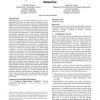Free Online Productivity Tools
i2Speak
i2Symbol
i2OCR
iTex2Img
iWeb2Print
iWeb2Shot
i2Type
iPdf2Split
iPdf2Merge
i2Bopomofo
i2Arabic
i2Style
i2Image
i2PDF
iLatex2Rtf
Sci2ools
MOBICOM
2006
ACM
2006
ACM
Coverage and connectivity in three-dimensional networks
Although most wireless terrestrial networks are based on twodimensional (2D) design, in reality, such networks operate in threedimensions (3D). Since most often the size (i.e., the length and the width) of such terrestrial networks is significantly larger than the differences in the third dimension (i.e., the height) of the nodes, the 2D assumption is somewhat justified and usually it does not lead to major inaccuracies. However, in some environments, this is not the case; the underwater, atmospheric, or space communications being such apparent examples. In fact, recent interest in underwater acoustic ad hoc and sensor networks hints at the need to understand how to design networks in 3D. Unfortunately, the design of 3D networks is surprisingly more difficult than the design of 2D networks. For example, proofs of Kelvin's conjecture and Kepler's conjecture required centuries of research to achieve breakthroughs, whereas their 2D counterparts are trivial to solve. In this pap...
Related Content
| Added | 14 Jun 2010 |
| Updated | 14 Jun 2010 |
| Type | Conference |
| Year | 2006 |
| Where | MOBICOM |
| Authors | S. M. Nazrul Alam, Zygmunt J. Haas |
Comments (0)

